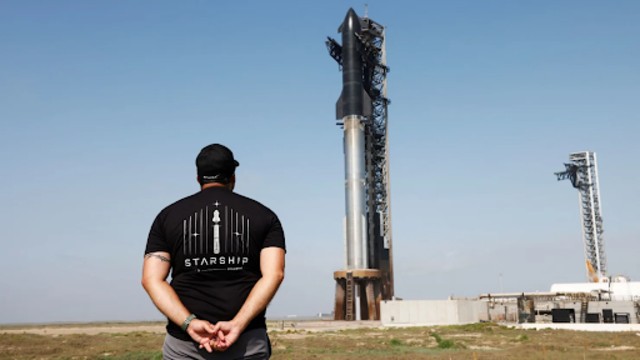
Matt Farrah of Newcastle, Australia views SpaceX’s next-generation Starship spacecraft atop its Super Heavy booster is prepared for launch on its ninth test at the company’s launch pad in Starbase, Texas, U.S., May 27, 2025. Reuters
SpaceX ninth Starship test flight ended in yet another fiery failure on Tuesday. The uncrewed mission marked the third explosion in a row for the world’s most powerful rocket system, stacking fresh pressure on Elon Musk’s space ambitions.
400 Feet of Power Goes Up in Flames
The two-part system—Starship rocket and Super Heavy booster—reaches about 400 feet when stacked. Designed to carry people and cargo around Earth and to the Moon, it's also central to Musk’s long-term dream: building a city on Mars.
But Tuesday’s flight didn’t get very far.
A livestream on SpaceX’s website and social media showed the booster exploding shortly after liftoff. The Starship spacecraft then leaked fuel, lost control mid-air, and disintegrated during reentry.
FAA Confirms “Anomaly” in Test Flight
The Federal Aviation Administration (FAA) acknowledged the failure, calling it an “anomaly.” The launch took place from Starbase, Texas. Fortunately, there were no injuries or damage reported to public property.
The FAA said it’s working closely with SpaceX to investigate the incident.
Musk Stays Optimistic Despite Setbacks
Despite the dramatic failure, Musk remained hopeful. Posting on X (formerly Twitter), he highlighted small wins. “Starship made it to scheduled engine cutoff, so big improvement over last flight,” he wrote.
He also noted that the rocket’s heat shield tiles held up better this time. But leaks during the coast and re-entry phases caused the main tank to lose pressure—ultimately leading to the explosion.
Next Launch in 3 to 4 Weeks
SpaceX isn’t slowing down. Musk vowed to ramp up test flights to one every three to four weeks. Thanks to a recent green light from the FAA, the company can now exceed its previous limit of five annual launches from its Texas site.
“Success comes from what we learn,” SpaceX posted on X. “Today’s test will help improve Starship’s reliability as we aim to make life multiplanetary.”
The company did not respond to media requests following the failure, referring to the explosion as a “rapid unscheduled disassembly.”
Billions at Stake for SpaceX
SpaceX’s funding remains rock-solid. Since 2008, the company has received over $19 billion from the U.S. government. It’s expected to receive billions more annually in the coming years.
The firm, along with two partners, is also in the lead to secure a major role in President Donald Trump’s ambitious “Golden Dome” missile defense program, as earlier reported by Reuters.
Musk’s Reach Extends Beyond Space
Musk’s influence isn’t limited to rockets and Teslas. He also heads the AI startup xAI and leads the Department of Government Efficiency (DOGE) under the Trump administration.
Under his direction, DOGE has drastically reduced the federal workforce and cut funding to multiple agencies—including those that oversee Musk’s companies, such as the FAA and EPA.
Another Setback, Another Step Forward?
While the third straight Starship failure may seem like a setback, SpaceX remains undeterred. For Musk, each explosion is a learning opportunity. As long as the rockets keep launching, his dream of a multiplanetary future is still alive.















